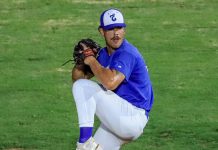Just to the left of the flat-screen TV, the empty wall in the family living room bugs Brendan Burns. He wants something to hang there. It’s a Type B personality trait, says Burns—unlike his mother Heather’s Type A. “With his competitive drive, he could be almost an A,†says Heather, opting to label her son a B+.
“B†is the last audible thing Burns typically hears before he goes underwater. Both parents shout, “Go B!†before his races. When her son was 12, Heather yelled it into the rafters at the Eastern Zone Championships in Webster, N.Y., knowing it would ricochet off them toward her son. Seven years later, back at their Berwyn home, her son must now fully process the cancellation of what would’ve been his first NCAA Championships, two weeks after a stunning debut at the Big Ten event. The Olympic Trials were supposed to come next in June, and then the Games in Tokyo, had he qualified. “It’s crushing, honestly,†says Burns, who will be a sophomore at Indiana University this fall.
Thinking he might return to school sooner than reality dictated, Burns left his Big Ten medals at Indiana, the championships’ host school. There, he took first in the 200-yard butterfly, first in both his medley relays, second in the 100 backstroke, third in the 100 fly and third in the 800 freestyle. As a team, Indiana—a three-time defending champion—finished third. Michigan won.
At home in Berwyn, Burns’ father has a 90-minute highlight video from the Big Ten Network ready to go. On it, the broadcasters note that Burns had the second best age-group time for the 200-yard butterfly in the sport’s history while at Conestoga High School—only falling short of 28-medal Olympian Michael Phelps. As he watches himself in the event, Burns has little reaction, until this delayed response: “It hurt—my stroke tightened up.â€
Burns won by half a body length. “I wish we had Netflix for the NCAAs,†he says. “I’d watch it—and not just the NCAAs, but the Olympic Trials, too.â€
There are two basketball hoops in the driveway of the Burns home. “They don’t get used that often,†says Burns.
Burns’ dad swam for Southern Connecticut State University, and his mom for Miami University (Ohio). They met as swimmers. Brendan’s sister, Delaney, just finished her sophomore year at Conestoga, qualifying for YMCA Nationals as he did for so many years. “When I was younger, I used to think it’d be so cool to have a pool in the backyard,†says Burns. “Now, I ask why I’d want to be in the pool all day, and then come home to another pool.â€
On this mid-March morning, Burns is returning to the water for the first time since the quarantine slowed everyone’s pace—a pool in Voorhees, N.J. “Man, it’s hard to grind it out and swim, knowing there’s nothing to look forward to in the immediate future,†he says. “The plan was to come home, and the Y would be open. Now, I can’t even see anyone—not even in my old stomping grounds.â€
That morning, Upper Main Line YMCA—his second home—erected barricades at the entrance. “I’ve been going to the Y for over 10 years, and I’ve never seen that,†he says.
No one has seen the likes of Burns around here since Brendan Hansen, a Haverford High School alum who won four consecutive state championships in the 100 breaststroke, then captured 16 All-American honors and 14 NCAA championships at the University of Texas, ultimately becoming a three-time Olympian and six-time medalist. Burns’ Indiana coach likes “Philly guysâ€â€”tough, gritty, with an edge. “With that societal mix, I like to dig into that grit,†says Ray Looze, who’s completed 18 seasons with the Hoosiers. “I did everything to recruit [Burns] and got him.â€
Baseball was Burns’ first love, but he loathed its politics and subjectivity. At 10, he participated in the Pennsylvania YMCA State Swimming Championships, where he won the 50 fly. That moment changed his perspective. “With swimming, you’re on the clock, and the clock doesn’t lie,†he says. “You qualify for a meet because you made the cut. That’s what drew me in.â€
For those who might say that Burns was a natural swimmer, he doesn’t agree. “I had to work for it,†he says.
And he’ll need to continue to work. “Brendan is a typical 18- or 19-year-old who experienced what freshmen typically do,†says Looze, who was on the 2016 U.S. Olympics staff and may also be involved in the 2021 Games. “Even at practice, he looked like a typical freshman with room to grow.â€
Then race day arrives. “He completely transforms,†says Looze. “He becomes an assassin, has no remorse and will do anything in a race to win.â€
At the Big Ten Championships, two of the guys he beat in the 200 fly were veteran seniors and repeat place winners at NCAAs. “It’s the way he beat them—right at the end,†his coach says. “He does things in a race that I don’t see in practice. You can just tell when he gets on the block—that dude wants to win.â€
Big Ten Freshman of the Year and a First Team All-Big Ten selection, Burns swam a career-best 200 fly (1:40.98) at the conference championships. His silver in the 100 backstroke (45.75) and bronze in the 100 fly (45.47) were also bests. The two winning relays set pool records. In all three, Burns swam career-best times and made the NCAA cut.
At Indiana, the 6-foot-2 Burns added 10 pounds of muscle, and he now fluctuates between 195 and 200 pounds. His weekly college routine includes three weight-lifting sessions and nine practices. “I’ve known hundreds of swimmers who get so nervous they think too much,†Burns says. “I don’t think about a damn thing. I just swim and turn my brain off. I just race. I guess I’m just a doer, not a thinker.â€
Burns’ underwater kick is the strongest part of his technique. “Even in age-group years, it was stressed,†says Burns. “At Indiana, I have a whole practice dedicated to underwater work. It’s not about how well you can do it, but how long you can do it.â€
Burns gets six or seven kicks off the wall for 200-yard events, and eight or nine kicks for 100-yard races. “The idea is to minimize the number of strokes and reduce fatigue,†he says.
Burns is mentally obsessed with his sport, even if he doesn’t think about it when he’s actually swimming. “I’m a swimming nerd,†he says. “I’m into the history of swimming. I love watching race videos of random meets. When I was younger, of course, I watched Phelps and Aaron Peirsol. I’m one of the few I know swimming at my age who are as obsessed as I am.â€
That obsession could’ve taken Burns to the University of Texas, which was among the 30 schools that offered him a full scholarship—and the one he says would’ve won NCAAs. But he “loved†Indiana more. Burns is studying business management, though competing in the Olympics is his first goal. After that, he wants to become a TV swimming analyst like ’84 Olympic gold medalist Rowdy Gaines. “That way, I can continue to do all the fun parts in swimming without doing the swimming,†he says.
“With swimming, you’re on the clock, and the clock doesn’t lie. You qualify for a meet because you made the cut. That’s what drew me in.â€
Swimming is the hard part, especially if you’ve already spent half your life in the pool. Accolades help. During his prolific high school career, Burns didn’t lose an individual race after freshman year. He was a three-time state champion in the 100 fly and 100 back. He was the only boy in state history to win two individual events three consecutive years, and the first swimmer in the state to finish the fly in fewer than 47 seconds. He also holds every Conestoga swimming record except the 100 breaststroke, and he won seven District 1 titles. Burns set the national public high school record in the 100 fly in 2018. The next year, he did it in the 200 freestyle.
All the while, he was also cruising at the club level, where he worked his last five years with Upper Main Line YMCA competitive aquatic director Lou Petto. “He’s the perfect combination of talent and drive,†Petto says. “He’s as competitive as anyone, enjoys putting in the work and has a great conception of the big picture.â€
Burns’ dad knew his son had the potential to turn heads after his performance in 200 fly at the USA Swimming Winter Nationals. He swam a 1:42.94, history’s second-fastest time in the 15-16 age group, behind Phelps’ 1:42.10. He finished the race second to Ohio State sophomore NCAA champion Noah Lense, a swimmer four years his senior. He also finished fifth overall in the 100 back and was named the best swimmer under the age of 18. While there, he battled three Olympians, including gold medalist and world record holder Ryan Murphy. Burns was the youngest swimmer in all of his finals, and it was already his third U.S. National meet.
Yet Burns was purposefully held back. At 13, he made YMCA Nationals, but Petto didn’t bring him. “We knew how talented he was, but there are only so many big-level meets before you get mentally exhausted,†he says. “It was a joint effort (with the parents), but the swimmer has to buy into it, too—and he was always chomping at the bit to do more.â€
Burnout can be tough to avoid, and that first year away from home wasn’t easy for Burns. “I was getting my butt kicked at practice, had a heavy volume of schoolwork and living out of a suitcase,†he says. “But the staff in the athletic department kept me grounded and reminded me why I was there,†he says. “You can have endless achievements, and they’re all great. But, for me, swimming is about the people I’ve met. I remember that and keep focused on goals, making it hurt and then getting the rewards.â€
To fill those walls.




